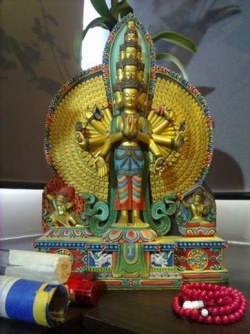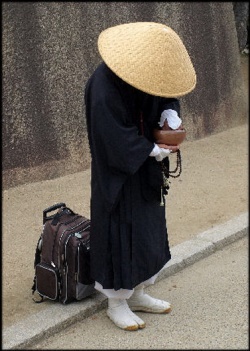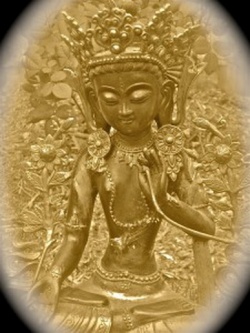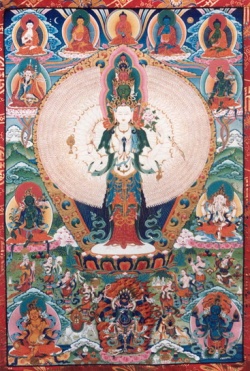Wendi Adamek’s ‘The Mystique of Transmission’
by Monica
Note: This is the first of two book summaries regarding the academic study of Chan/Zen Buddhism. The Mystique of Transmission: On An Early Chan History and Its Contexts was published by Columbia University Press in 2007. It is the subject of the author’s doctoral thesis and has been described as ‘dense’ by one of my professors. However, overall I found it a
very interesting book. It focuses on a truly obscure and only recently rediscovered Chinese Chan text, the Lidai fabao ji, but it does so in a way that carries with it an enormous amount of history (its contexts) from the period leading up to, during, and just after the time the text was written, the Tang Dynasty or eighth century China, sometimes (erroneously?) called the “Golden Age of Chan.”
There is a fundamental difference between the academic scholarship of religion and the study of theology which must be made apparent. Academic religious scholars, for one thing, seem (seem!) to have no interest regarding the truth of religious claims. Rather they act more as historians, linguists, archaeologists, and interpreters than as
theologians, monks, nuns, or priests. Therefore, in this semester’s course of study on Chan Buddhism, we have witnessed many of the most orthodox claims of Chan, from Bodhidharma to Linji (Rinzai) being systematically debunked. This may feel very threatening to a Chan or Zen Buddhist (though the two monks in the class are handling it with aplomb). However, I find such study invigorating because it helps me understand people. And after all, wasn’t that why I started studying Buddhism in the first place? I hope you’ll find it equally as invigorating.
Summary of The Mystique of Transmission: On an Early Chan History and Its Contents by Wendi Adamek
This book primarily concerns the Lidai faboa ji (Record of the Dharma-Jewel Through the Generations) composed sometime between 744 and 780 CE by the short-lived Bao Tang sect of Chan at the Bao Tang Monastery in Yizhou, Jiannan (Sichuan), regarding their master Wuzhu (714-774). The manuscript was long lost, though known about and quoted in
other sources, and only rediscovered in the Dunhuang caves in 1900. The book “has been called a fabric of self-promoting fictions,” and was largely regarded as such from its beginning. However, that does not mean its influence was not and perhaps is still felt on the larger fabric of Chan literature, “In this study I argue that the fabrications in the Lindai fabao ji are not simply inaccurate Chan history but faithfully reflect a temporary crisis in the meaning of spiritual transmission.”(pages 3-6)
Perhaps the most outlandish claim is that Chan Master Wuzhu was in possession of the robe of Bodhidharma, the first Chan patriarch. This is the robe which lore often claims was given to Huineng (638-713) by Hongren (602-675) as part of the Southern School’s elaborate transmission lineage. “It is clear that the Lidai fabao ji’s multifaceted and unorthodox (or pre-orthodox) account of Chan transmission was deployed as part of a strategy to claim authority – but what kind of authority?” Adamek asks. She goes on to explore this and other questions in seven chapters, followed by an annotated translation of the Lidai fabao ji not be discussed here. Throughout this exploration, she “highlights the instability of received Buddhist criteria determining standards of authority and morality” during this period of the Tang Dynasty, both before and following the composition of the Lidai fabao ji, putting the work in its proper historical context. (pages 4-5)
Chapter 1 Authority and Authenticity provides an introduction to the Lidai fabao ji and an overview of the book as a whole. The book is in roughly two sections, the first a set of linear biographies in an early version of the chuandeng lu format, and the second a recording of Wuzhu’s dialogues written as a zhenzan (portrait eulogy). The Bao Tang is also notable for taking the Southern School monk “Shenhui’s doctrine to a certain logical extreme by advocating iconoclastic and antinomian approaches to practice.” This is reflected in the term “crisis of transmission” in which there is a “necessary instability” found in a system in which authority is based both on ordination but also “the individual’s experience of truth.” Adamek argues that “neither realization nor realpolitik is reduced one to the terms of the other.” (pages 10-12) The chapter ends with a summary of the remaining six chapters and an identification of three themes found throughout Adamek’s book: 1) transmission, specifically methods, means and their validity, 2) historical narrative including Dharma lineage, the role of secular rulers, and sources and styles of discourse, and 3) political aspects for the propagation of the above two. (pages 14-16)
The second chapter, Transmission and Translation, provides a summary of the Lidai fabao ji in which Adamek seeks to pay particular attention to how the authors may have been influenced by the issues of the time. The author examines the episodes presented in the Lidai fabao ji in light of “new developments in the empowerment” of monastics in Chinese society and the ongoing tension between individual realization and the “culturally contingent forms” used to transmit teaching. (pages 17-18)
The Lidai fabao ji starts with a list of thirty-seven ‘sources,’ from which “freely altered quotations” make up about a quarter of the text. It uses these ‘sources’ to lay out a historical narrative beginning with Buddhism’s entry into China under Emperor Ming of the Han and culminates in the story of Wuzhu himself, founder of the Bao Tang school. Adamek investigates the social meaning of each historical incident in this narrative as it would have been understood during the time the Lidai fabao ji was being written. It also includes the biographies of the six Chan patriarchs starting with Bodhidharma (d. ~530) and ending with Huineng (638-713) who gives Bodhidharma’s robe to Empress Wu Zetian and a lineage of how the robe came to Wuzhu thereafter. In addition, the Lidai fabao ji uses parts of Shenhui’s dialogues to “interpolate a spurious commentary on Sichuan Chan figures” of the time. The remaining majority of the text is dedicated to Wuzhu’s biography and dialogues, concluding with his death scene. (pages 19-21) Through the portrayal of this history and from Wuzhu’s discourses, Adamek demonstrates that “the Bao Tang defined itself through rejection of norms that originated in the early period,” such as meditation teaching and ritual, seeking an even more antinomian stance than ‘regular’ Chan. (page 54)
Chapter Three, Transmission and Lay practice, ties together the authority of full ordination, a criteria for authentic transmission of the Dharma based on Indian Buddhism, and the practices of laypeople including the bodhisattva precepts. Through a look at Chinese apocryphal writings, she shows “the confluence of visualization practice, bodhisattva precepts, and repentance practices” from both lay and ordained sources taking place within the Bao Tang monastic sangha. The tolerance for lay groups being to some extent self-defining was reinforced in Chinese apocryphal writings of the time. In this way, the Bao Tang often appeared to function more like lay societies than a monastic sect “by practicing according to their own criteria of authenticity.” However, the Lidai fabao ji did critique some of the common lay practices, including “seeking visions of the Buddha and bodhisattvas” as a way to “confirm the efficacy of one’s practice.” (pages 89-90)
In Chapter Four, Material Buddhism and the Dharma Kings, Adamek shows how Chan patriarchy developed under the tension of both “ideologies of Buddhist utopia and ideologies of Buddhist end-time.” “Spiritual materialism,” she claims, was fed by fears of decline. Buddhist expansion was at a high point during the reign of Empress Wu, feeding off the “assurance that the champions of the Dharma will hold firm.” The Bao Tang is notable in that it made use of Shenhui’s debates from that time to bolster their own authority and authenticity, often presented in more extreme forms, but “without reference to mofa [last-age] eschatology.”
Chapter Five, Robes and Patriarchs, concerns the various debates going on within Chan discourse. First of all, it starts off with recent scholars’ claims that “Chan” itself as a label was applied retroactively to various groups who did not separate and self-identify their practices as such. However, Adamek points to a more distinct attempt by the authors of the Lidai fabao ji to set themselves apart by “represent[ing] their contemporaries as mechanically following a standard monastic regimen,” while “the Bao Tang insisted on a separate identity that was based on a particular lineage and a particular form of (formless) practice.” (pages 136-137)
The chapter then continues to deal with how the stories of the Chan patriarchs, the above mentioned “particular lineage,” are presented, including Bodhidharma as seen by Daoxuan, accounts of self-sacrifice, and the conferring of Bodhidharma’s robe. She traces the genealogy of the patriarchal lineage through its various source texts. Shenhui’s rhetorical campaign against the so-called Northern schools was given a new twist by the Bao Tang. “Through a fantastic manipulation of the ‘imaginary cultic history’ of Bodhidharma’s robe, the Lidai fabao ji authors managed to include Huineng in their transmission narrative.” Shenhui is the “only nonlineage master whose words and deeds are featured,” because it is through him that Huineng’s own legitimacy was established. (page 171) As previously mentioned, the Bao Tang also followed Shenhui’s rhetoric to its most logical extreme and antinomian position.
In this chapter, Adamek also examines the “most frequently disputed claim” regarding Bodhidharma’s robe. The robe itself stands in for the Dharma transmission that could not be physically accomplished because Empress Wu, who was not a patriarch, received the robe from Huineng and gave it to the Dharma ‘grandfather’ of Wuzhu’s master. There are all kinds of problems with this sort of ‘transmission’ “characterized by several kinds of inversion,” beyond the simple dispute of whether it happened at all. (pages 182-183)
Chapter Six, Wuzhu and His Others, is where we begin to see most clearly how the concerns in Chapters Three, Four, and Five are linked to the Lidai fabao ji in the second half of the eighth century. It is in the second half of the Lidai fabao ji that “Wuzhu takes center stage.” Adamek uses the historical context already laid out to 1) discuss how methods and meanings of ordination at the time “influence Bao Tang identity,” 2) the robe transmission and Wuzhu’s relationship to the various historical figures of the Lidai fabao ji, and 3) Wuzhu’s teachings and dialogues. In this last section, Adamek calls out three themes within the text: antinomianism, inclusion of women, and anti-Daoist rhetoric. In this chapter, “we look at paradigmatic representations of the Bao Tang through stories of their heroes and heroines, followers and foes … [which] serves to validate existing hierarchies, clarify family values, and demonstrate the effectiveness of Wuzhu’s patriarchy.” (pages 194-195)
This chapter covers the style of the writing in the Lidai fabao ji, Wuzhu’s master, Wuxiang, whom the authors argue “did not preach the ultimate teaching” (page 204), while Wuzhu did, and other Dharma teachers and Wuzhu’s relationships with and to them. She also discussed the antinomianism existing at Bao Tang Monastery and “firmly grounded in the ‘no-ground’ of subitism, the assertion that moral and formal distinctions belong to the delusory mind that is transcended in no-thought.” This is the extreme logical progression of Shenhui’s rhetoric. It is established through a “rather one-sided dialogue with a group of Vinaya masters who come to call.” (pages 218-219) The chapter rounds out with a somewhat positive portrayal of nuns and laywomen (that “blurred the line between” lay and ordained and male and female practitioners) and a negative portrayal of Daoists (perhaps in response to Daoism gaining favor in the court of Emperor Xuanzong at that time) in the Lidai fabao ji by means of another dialogue.
The final chapter, seven, The Legacy of the Lidai fabao ji, first discusses the zhenzan at the end of the text and its purposes, and second, follows the influence of Wuzhu and his purported master, Wuxiang, in Sichuan, Korea, and Tibet. Although the Bao Tang did not survive past the generation of Wuzhu’s immediate disciples, “Sichuan Chan became an important source for the styles, traditions, and practices of mainstream Chan in the Song dynasty,” with the Bao Tang making a “not negligible” contribution. While the Lidai fabao ji was itself forgotten, many of its anecdotes survive in other compilations, its lineage of Indian patriarchs was the source of the “official” one, and it influenced the development of the chuandeng lu, yulu and zhenzan genres of Chan literature. (pages 292-293)
In the conclusion, Adamek is critical of the Bao Tang, while complimentary of Wuzhu himself. She describes the sangha as “engaged in Buddhist business as usual, wearing the cloak of disinterestedness in order to attract secular elites” and the master as someone who “truly went into this marketplace with empty hands, offering no sin and repentance, no merit, and no-thought.” She continues and concludes with this thought: “If indeed the Bao Tang practiced no-thought to the extent of dispensing with the costumes, masks, and script, so that their own separate status as clergy all but disappeared, this should win them a special place in the history of Buddhist monasticism. Bao Tang antinomianism was lost in the mainstream of Chan. Repudiated, it nevertheless imparted a subtle pervasive flavor, and perhaps a warning about the necessary limits of ultimate teaching.” (page 296)
Overall, Adamek’s attention to the context in which the Lidai fabao ji was written and how the understanding, concerns, and motivations of the authors influenced the text is commendable. In this way, what the Lidai fabao ji says is somewhat secondary to what it means, an approach I personally find both more edifying and satisfying.




